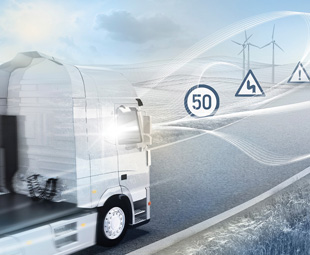Taking a drive through the cloud

Soon all vehicles will be able to communicate with one another – resulting in increased safety, efficiency and occupant comfort. AIMEE SHAW heads into the “cloud” to discover how Europe’s vehicles of the future will include a new generation of embedded technology.
Vehicles are transforming and integrating into a digital landscape of their own. As a result, the internet and the vehicle are no longer separate entities. With a rise in cloud connectivity, particularly in Europe, the traditional “isolated vehicle” is evolving into the modern “connected vehicle”.
Cloud computing uses an internet connection that does not require any data to be stored on the user’s device. Smartphones, tablets and other devices are able to give the user remote access to their vehicle’s information, which is stored in the cloud. This allows the user to access web-based music, information and a multitude of other services. The only requirement is to have internet access.
Bosch, a German engineering and electronics company, has developed software called SoftTech, which can be used to access maps and gather data from within the cloud. This technology is specifically focused on vehicle infotainment − described as a collection of hardware and software used both to entertain and to inform.
Infotainment also enables drivers to update their systems automatically, while ensuring continuous communication relating to traffic data. After the system has retrieved the appropriate data, it is then able to deploy relevant information directly to the user’s cloud.
“There is an increase in the growth of connected vehicles at the moment,” says Mark Boyadjis, senior analyst for Automotive Industry Solutions (AIS). AIS draws attention towards information that is relevant for product and market innovation. He says the vehicle is the third-fastest growing connected device after smartphones and tablets.
 Statista’s Digital Market Outlook (DMO) estimates that there will be approximately 8,6 million “intelligent cars” on Europe’s roads by 2020. Statista’s DMO is an online statistics portal, focused on detailed forecasts and market insight appropriate to the digital economy.
Statista’s Digital Market Outlook (DMO) estimates that there will be approximately 8,6 million “intelligent cars” on Europe’s roads by 2020. Statista’s DMO is an online statistics portal, focused on detailed forecasts and market insight appropriate to the digital economy.
The DMO predicts that cloud computing will become more relevant for security and driving assistance, as opposed to infotainment. This has led to a growing number of partnerships between technology and automotive companies.
Google, Apple and Microsoft are seeing a gap in the market with an ever-changing consumer demographic. There is now more attention directed towards affordable, flexible and “scalable” technological integrations, which are able to operate within a fluid environment.
According to the website Automotive News Europe, “Google and Apple have recently formed a partnership with Volkswagen: This will allow drivers to remotely check their fuel tank and to lock their vehicle from their mobile phone.”
As the industry explores a new market territory, challenges arise in the area of the management of information technology “assets”. With an increase in vehicle cloud computing, the significance of security is rising.
One of the main characteristics of cloud computing is the flexible movement of nodes. This refers to the data points of intersection within a larger network. Despite the benefits of communication now possible between various networks, a downside of cloud computing is the possibility of security threats.
These challenges include authentication, secure location information, message confidentiality and secure vehicle communication. It is, however, possible to set up protection software with a series of processes known as “cryptographic algorithms”.
Another challenge for cloud computing is to overcome the likelihood of a connection failure. Cloud computing systems are internet-based, meaning the user’s access is solely dependent on the strength of their connection. As with all types of hardware, cloud platforms can fail at any time, and a secure connection is required for a moving vehicle.
“The idea is to connect the smartphone with the user interface of the vehicle, which will make the interaction safer,” adds Boyadjis. Furthermore, drivers will have access to real-time information from in-vehicle telematics.
Using cloud computing, real-time information is delivered to the user immediately after collection. This would enable the cloud backend to integrate telecommunications and information technology.
Despite the challenges, cloud computing is gradually advancing towards becoming an integral part of the automobile industry. The industry continually seeks to cut costs and to deliver appropriate market-specific vehicles.
Cloud computing could best be described as an advanced technological “connection” innovation, which is able to offer significant and wide-scale benefits for the drivers of tomorrow!
From effortlessly avoiding traffic jams to paying for parking and toll fees, drivers can benefit from a range of services from the comfort of their vehicles.
Published by
Focus on Transport
focusmagsa




